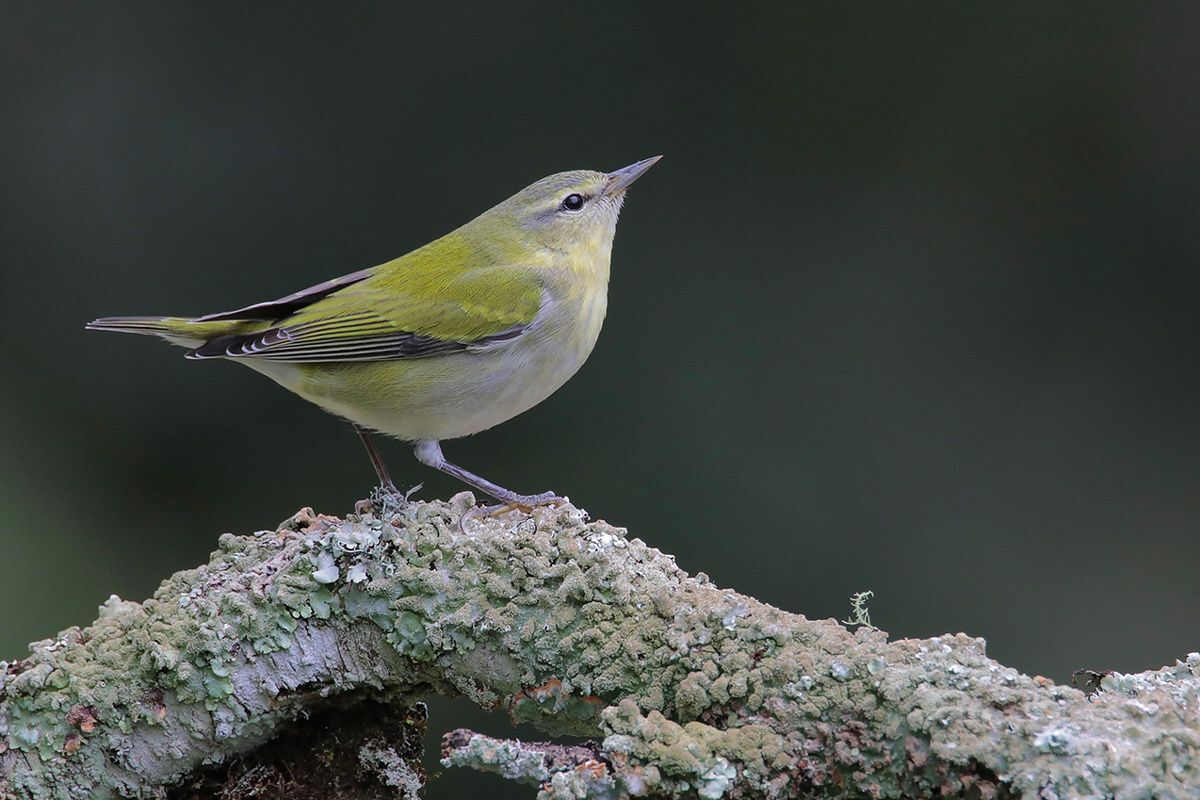Tennessee Warbler

© Greg Lavaty
Leiothlypis peregrina
Family: (Parulidae) Wood-Warblers
Preferred Habitat: Woodlands.
Seasonal Occurrence: Common in spring; uncommon in fall.
Profile by Glenn Olsen: Spring migration was underway on an early April morning as those in my warbler identification class walked toward Boy Scout Woods. Just ahead, bright colors flashed as a male Baltimore Oriole flew across the road and into an Australian bottlebrush. I called out for everyone to look at the bottlebrush as more birds flew into it. The shrub looked like a Christmas tree adorned with colorful ornaments of Baltimore Orioles, Orchard Orioles, Tennessee Warblers, and the bright red flowers of the shrub. Both orioles have distinctive color patterns and are easily identified, but the Tennessee Warbler’s color pattern is subtle, and this species often presents identification challenges.
Like many warblers, the Tennessee is most often moving about in a tree or shrub searching for food; and getting a good look is not easy. The overall image is a thin, sharply pointed bill, a small body, short tailed, no streaks, or spectacles and no wing bars on the bird. The gray crown and nape of the male is distinct and contrasts with the olive green to yellow green upperparts of the bird. The entire underparts are off white to gray-white. The male’s facial pattern is a key for me, namely a thin bill, a thin white eyebrow, and a thin gray eyeline with a white to pale grayish face, and gray crown. The female is similar but much paler with less contrasting color and most often has a yellowish tinge of color on the upper breast and throat. I think that the color pattern of the Tennessee most closely resembles some vireos, like the Philadelphia, Red-eyed and Warbling. But a close look at the bill of the Tennessee, that is fine and needle-sharp, eliminates any species of vireo.
We most often see Tennessee Warblers during spring migration, primarily mid to late April, as they head to their breeding grounds in Canada and the northern U.S. So this April take up the challenge of finding, identifying, and enjoying the subtle beauty of a Tennessee Warbler as it passes through.
Comments by Don Verser: Some first fall Tennessee Warblers can have very yellowish underparts and look quite different from spring birds. These can be easy to mistake for Orange-crowned Warblers. Always look at the undertail coverts which should be distinctly white for Tennessee and yellow on Orange-crowned.
Profile by Carrie Chapin: The Tennessee Warbler is one of the many species to pass through the Upper Texas Coast during spring migration. This warbler was named because the first cataloged specimen was collected in Tennessee, but that is only one of the many states this species frequents during migration. Migrating individuals can be spotted in all U.S. states east of Montana. In spite of this restrictive name, Tennessee Warblers overwinter in Central and South America and breed in northern Maine, Michigan, and throughout the boreal forests of Canada. Perhaps its Latin name, peregrina, from the Latin word for wanderer, is a more apt title.
Tennessee Warblers can be identified by their pointed bills, lack of wing bars, and white undertail coverts. Male individuals have a gray head, green back and wings, a dark line through the eye, and a white chin. Females are more olive overall but still have a faint eyeline and pointed bill. The most similar species, the Orange-crowned Warbler, is differentiated from the Tennessee by the Orange-crowned’s yellow undertail coverts and less distinct eyeline. Tennessee Warblers prefer to forage near the tops and middle of trees, gleaning insects from leaves in mixed flocks with other warblers and vireos.
Tennessee Warblers nest in regenerating mixed coniferous forests with open areas and dense shrubbery. Pairs make a cup-shaped nest near the ground in the roots of fallen trees or around clumps of sphagnum moss. The female lays between five and six eggs and incubates them for about 12 days. The male brings her food during this time and defends the territory from conspecifics (members of the same species). After hatching, both parents feed the young for 12 days, after which the young leave the nest. The quantity of spruce budworm caterpillars influences the success of nesting, with larger warbler populations irrupting after a good budworm season. Interestingly, despite their reliance on caterpillars in the spring and summer, in the winter, Tennessee Warblers add nectar to their diet, using their sharp bills to drain the nectar from tube-shaped flowers. The Tennessee Warbler is a species of least concern; its success is most likely due to its extensive overwintering range and broad use of habitats.
To find this species, scan mixed flocks of warblers and vireos near the tops of deciduous trees. The McGovern Canopy Walkway at Smith Oaks Sanctuary in High Island is also a great spot to see them up close. You may even find one foraging in the tree in your backyard!
-
Cornell Lab of Ornithology
-
Field Guide
-
Bird Library

© Greg Lavaty, www.texastargetbirds.com

© Greg Lavaty, www.texastargetbirds.com

© Greg Lavaty, www.texastargetbirds.com

© Greg Lavaty, www.texastargetbirds.com




















